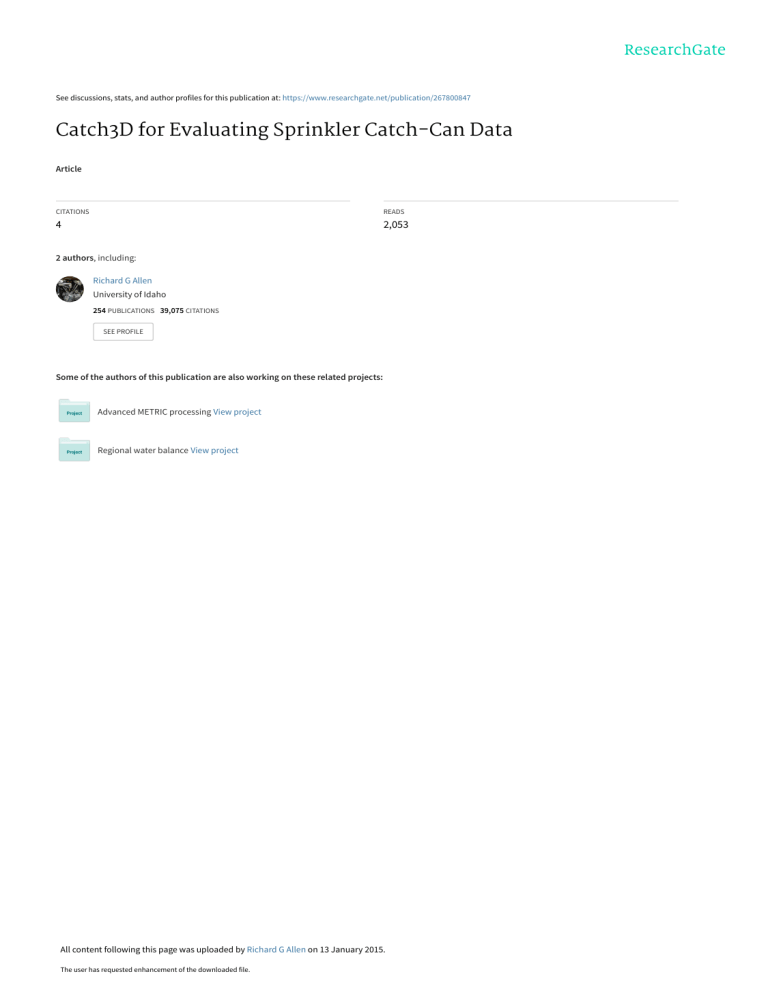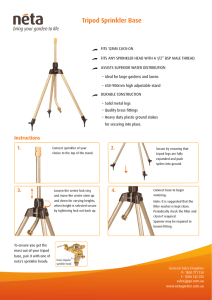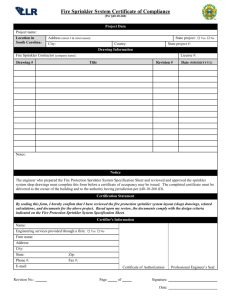
See discussions, stats, and author profiles for this publication at: https://www.researchgate.net/publication/267800847 Catch3D for Evaluating Sprinkler Catch-Can Data Article CITATIONS READS 4 2,053 2 authors, including: Richard G Allen University of Idaho 254 PUBLICATIONS 39,075 CITATIONS SEE PROFILE Some of the authors of this publication are also working on these related projects: Advanced METRIC processing View project Regional water balance View project All content following this page was uploaded by Richard G Allen on 13 January 2015. The user has requested enhancement of the downloaded file. Catch3D for Evaluating Sprinkler Catch-Can Data G.P. Merkley1 and R.G. Allen2 Abstract A new version of a computer program, called “Catch3D,” to evaluate sprinkler catch-can data and water application uniformity has been developed as a 32-bit application with a redesigned interface and new capabilities. Catch3D provides spreadsheet-style interactive data editing, complete statistical data analysis, and a rotatable 3-D view of overlapped and non-overlapped test values. Catch-can values may be arranged in a grid or one or more radial legs, and the application can handle center pivot data analysis, with dynamically-allocated memory features to accommodate even the largest data sets. The program can read and write data to text files, the Windows® “clipboard,” compressed files, and formats used by other programs. English, Spanish, and Portuguese language interfaces are included, as well as numerous other options. The program is available free of charge from a web site, but with a suggested nominal registration fee. 1 Assoc. Professor, Biological and Irrigation Engrg. Dept., Utah State Univ., Logan, UT 84322-4105. Phone: (435) 797-1139. merkley@cc.usu.edu. 2 Prof. of Water Resources Engrg., Univ. of Idaho Research & Extension Center, 3793 N 3600 E, Kimberly, Idaho 83341 1 Introduction A computer application called “Catch-3D” with a text-based interface was developed in the 1980’s by Richard G. Allen (1995) to statistically analyze sprinkler catch-can data for agricultural irrigation systems. The program allowed convenient comparisons of unoverlapped and overlapped water application profiles, using different statistical indices of uniformity and application efficiency, and also included a color-coded wireframe graphical representation of the data. Other computer programs have been developed in recent years by various individuals and organizations for comparing sprinkler nozzle packages, sprinkler spacings, pressures, and other factors which affect application uniformity and efficiency. Some of the programs are primarily oriented toward sprinkler systems for landscape irrigation, while others focus on features found in agricultural sprinklers. The authors of this paper have collaborated on the development of an entirely new version of the Catch-3D software with a fully graphical interface and several new features, yet retaining the emphasis on application to the analysis of agricultural sprinkler systems. The new version of the program is described herein. The software and accompanying user’s guide are currently available as a free download from a web site at http://www.irri-net.org/merkley/index.htm. Evaluation of Sprinkler Irrigation Performance The evaluation of sprinkler irrigation performance is usually accomplished by one or more measures of water application uniformity and or water application efficiency indices. So-called “catch-can” containers (Fig. 1) have traditionally been used to measure depth or volume of water, as applied through one or more sprinklers, with statistical methods applied to the analysis of the data. The resulting performance indices are used to compare with the same indices from previous times, with other sprinklers and or nozzles, with different environmental conditions (e.g. wind, humidity, air temperature), and or with sprinklers in differing installations. Performance indices can also be evaluated based on absolute criteria, such as minimum coefficient of uniformity, when available and appropriate. Theses indices can then lead to the identification of ways in which sprinkler performance might be improved through equipment and or operational changes, allowing for the possibility of improved water management and increased agricultural productivity under sprinkler irrigation. 2 Figure 1. A catch-can test of a single sprinkler in the field. Software Features The software comes in only one version, but with a number of interface and technical options. The user can choose from English, Spanish, and Portuguese languages. The system of units can be metric or English, and catch data can be entered in milliliters, centimeters, or depth. When the catch data are in milliliters, the program converts volumes to depths according to a specified container opening area or diameter. Various field test parameters can be recorded in the program (Fig. 2), some of which are used in calculations and other for purposes of reference and documentation. Catch data can be entered in Catch-3D through a spreadsheet-like grid of cells (Fig. 3). The Microsoft® Windows© clipboard can be used to transfer catch data to and from Catch-3D from spreadsheet or text editing software applications. This allows for convenient “cutting” and “pasting” of data values between applications, which can be useful for data entry, editing, graphing, and analysis. Catch-can data can be imported into the program in two other common formats. Sprinkler evaluation data sets used in the Space ProTM program (Oliphant 2001) can be imported into Catch-3D and analyzed. Many such files are available from a web site maintained by the Center for Irrigation Technology in Fresno, California: http://cati.csufresno.edu/cit/good/profiles.html. Data files from the previous versions of Catch-3D are also recognized and can be imported directly into the new version of the software for data analysis and display. 3 Figure 2. Catch-3D parameters window. Figure 3. Catch-3D catch data window. Simulated catch data overlap can be generated for one or more sprinkler overlap spacings by specifying single values or ranges for rows and columns. Alternatively, the user can specify single values or ranges for distances, in meters or feet, between sprinklers (Fig. 4). Sprinkler overlap patterns can be simulated for square, rectangular, and triangular spacings. The sprinkler position can be entered into the grid to indicate its location. When a row or column of sprinklers, such as along a lateral pipe, are used for a catch-can evaluation, those data can also be entered to show the arrangement of 4 the sprinklers. This can be taken one step further to allow for a full grid of sprinklers in a sprinkler performance evaluation. Figure 4. Catch-3D sprinklers window. Sprinkler performance evaluations are often based on one or more radial legs of catch containers, instead of a full rectangular grid, so as to reduce the time and effort involved in the data collection. Data from up to four radial legs of catch-can containers, centered at a single sprinkler location, can be entered into the Catch-3D program, and then automatically rotated to produce a rectangular grid of approximate catch values. When multiple radial leg data are available, the data from each leg are interpolated according to the azimuth angle of the leg to produce a smooth, rectangular grid of application depth values. Interpolation between catch values along each radial leg, as applied to the generation of a rectangular grid of data, is selected by the user from these options: 1. Linear 2. Lagrange method 3. Natural cubic spline The performance indices produced by Catch-3D include the following: 1. 2. 3. 4. 5. 6. 7. Christiansen’s Coefficient of Uniformity (CU) Distribution Uniformity (DU) Standard deviation Kurtosis Skew Application efficiency of the low ¼ (AELQ) Application efficiency of the low ½ (AELH) 5 A coefficient of uniformity equation, as found in ASAE’s Standards (1994), number S436, is included in the program for the evaluation of catch data from center pivot sprinkler systems. For detailed technical descriptions of the above indices, the interested reader can consult one or more of these publications: Merkley & Allen (2003), ASAE (1994), Keller & Bliesner (1990), and Merriam & Keller (1978), among other references on the subject. The effective portion of the applied water (Keller & Bliesner 1990), which takes into account water losses due to wind drift and evaporation, is estimated based on the flow rate from the sprinkler(s), the duration of the test, and the calculated volume of water that arrived at the catch-can containers during the same period of time. The program provides fully rotatable three-dimensional wireframe views of both raw (unoverlapped) and overlapped catch data. Coordinate rotation is achieved intuitively and interactively through mouse movements in the main window of the program whereby problems such as “gimbal-lock,” which can eliminate a degree of freedom in 3D rotation, is avoided through the use of an algorithm based on quaternions. The wireframe view can be in black and white or colored, and can also be presented on the screen as a solid surface. The vertical scale can be exaggerated, if desired, in order to highlight the detail of the variations in water application depth from a catch-can data set. The user can also zoom in and out on the 3D view, and shift the view position left, right, up, and down. Figure 5 shows an example of a wireframe view in Catch-3D, in which a catch-can test produced results for a sprinkler operating at an insufficient pressure, giving a “donut” or partial torus shape to the profile. Figure 5. A wireframe view of a grid of catch-can values. 6 Other data views include a normal distribution curve superimposed upon a histogram of ranked catch data (unoverlapped or overlapped) and a text-based display of the performance indices. The user can toggle repeatedly between the three main views for the unoverlapped data and for any of the overlap patterns that might have been generated. The fineness of the catch-can grid can be repeatedly doubled in the program through the application of bicubic spines which interpolate between existing grid points to increase the mesh density. This can allow for the analysis of more sprinkler overlap possibilities, especially when the catch containers are spaced far apart. It allows for a more uniform graphical representation of overlap profiles of different sprinkler spacings which would inherently contain different grid densities. Sprinkler evaluation results can be written to a text file or printed, with options for the types of indices which can be included. Graphical views of water depth profiles and histograms can also be directly printed from Catch-3D, or files with the same graphical information can be created in two common formats. Summary A new version of the Catch-3D software was written for the analysis and display of sprinkler catch-can data. Several performance indicators are generated by the software for unoverlapped and overlapped depth profiles, with three main data views, including a rotatable three-dimensional wireframe representation of a grid of water depth values. The new version of the software is available as a free download from http://www.irrinet.org/merkley/index.htm. References ASAE. 1994. Standards. Amer. Soc. Agric. Engineers, St. Joseph, MI. 819 pp. Allen, R.G. 1995. Catch3D users manual. Utah State Univ., Logan, UT. 20 pp. Keller, J. and R.D. Bliesner. 1990. Sprinkle and trickle irrigation. Chapman & Hall, New York, N.Y. 652 pp. Merkley, G.P. and R.G. Allen. 2003. Sprinkle & trickle irrigation lecture notes, BIE 5110/6110. Utah State Univ., Logan, UT. 249 pp. Merriam, J.L. and J. Keller. 1978. Farm irrigation system evaluation: a guide for management. Utah State Univ., Logan, UT. 271 pp. Oliphant, J.C. 2001. Space Pro installation and operation manual. California Agricultural Technology Institute, Publication #991003. Fresno, CA. 30 pp. 7 View publication stats



